If you’re looking for a new electric guitar with two humbuckers and a mahogany body to give you a powerful and rich tone, then you’ve probably noticed that the PRS Custom 24 and the Gibson Les Paul crop up quite often in your search. But which is actually the best?
In this post, I’ll go through an in-depth comparison between both guitars and talk about all the main components, the sound, look and the feel so you can decide which is best for you.
A Quick Comparison
If you’re after a quick comparison between the two guitars then here is a guide to the features on both standard models. Of course some models have variations, but these features are found on most guitars in the range.
| Feature | PRS Custom 24 | Gibson Les Paul |
| Body Shape | Double Cutaway | Single Cutaway |
| Tone Wood | Mahogany | Mahogany |
| Pickups | Dual Humbucker | Dual Humbucker |
| Neck Shape | Wide and Thin | Rounded C Shape |
| Fret Board | Rosewood | Rosewood |
| Frets | 24 with Bird Inlays | 22 with Trapezoid Inlays |
| Scale Length | 25” | 24.75” |
| Bridge | Floating Tremolo Bridge | Fixed Tune-O-Matic Bridge |
| Weight | 8.5 pounds (3.9 kg) | 9-12 pounds (4.1-5.4 kg) |
Sound
Both guitars have a mahogany body and two humbuckers. Hence, they both handle gain very well and produce a warm and full tone with a lot of resonance and sustain.
The main difference in sound, is that the PRS Custom 24 comes with a coil split function which gives the humbuckers extra versatility to give you a twangier and brighter single-coil type sound. The Gibson Les Paul does not have this feature.
Another difference is the scale length. The Les Paul has a shorter neck which tends to produce more resonance. However, the scale length difference isn’t too dramatic.
The Les Paul has a fixed bridge which is easy to maintain and setup. The PRS however, has a tremolo bridge which gives you a vibrato type effect which is a great addition.
Look
Feel
In terms of feel, body guitars are fairly heavier. However, the Gibson is definitely the heaviest, so try them both whilst standing to see if you prefer the weightier Les Paul or lighter PRS.
The PRS has a wide thin neck profile meaning it’s pretty fast to play on. The Gibson neck is thicker and rounder, which some guitarists prefer, but others find it a bit slower to play on.
The double cutaway design of the PRS also makes it a bit easier to reach the higher frets, compared to the Gibson’s single cutaway design.
Key Features
Now we’ve been through the main differences and similarities between the two guitars, I’ll go through each aspect individually and in more depth.
Body
The body wood of both guitars is mahogany, usually with a maple cap on top. The result, is a highly resonant tone with plenty of depth and warmth. It’s great for a range of different styles of music and is the tone wood of choice for a lot of guitarists.
The main difference between the bodies of both guitars, is due to the shape. The Les Paul has a single cutaway design, whilst the PRS Custom 24 has a double cutaway design which tends to increase the accessibility of the higher frets.
The PRS has a thinner body compared to the Les Paul. Hence, it’s usually more comfortable for most players. It’s all personal preference though, and there’s no denying that both guitars look great.
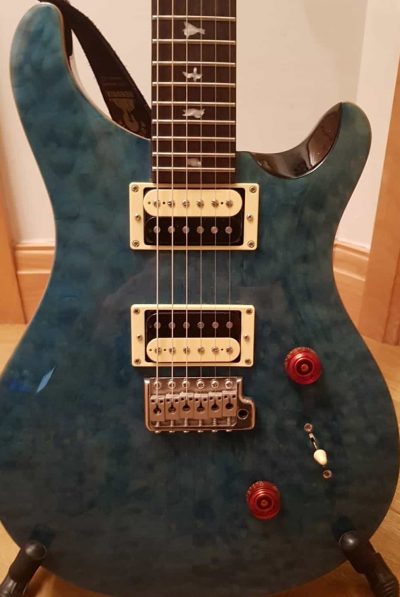
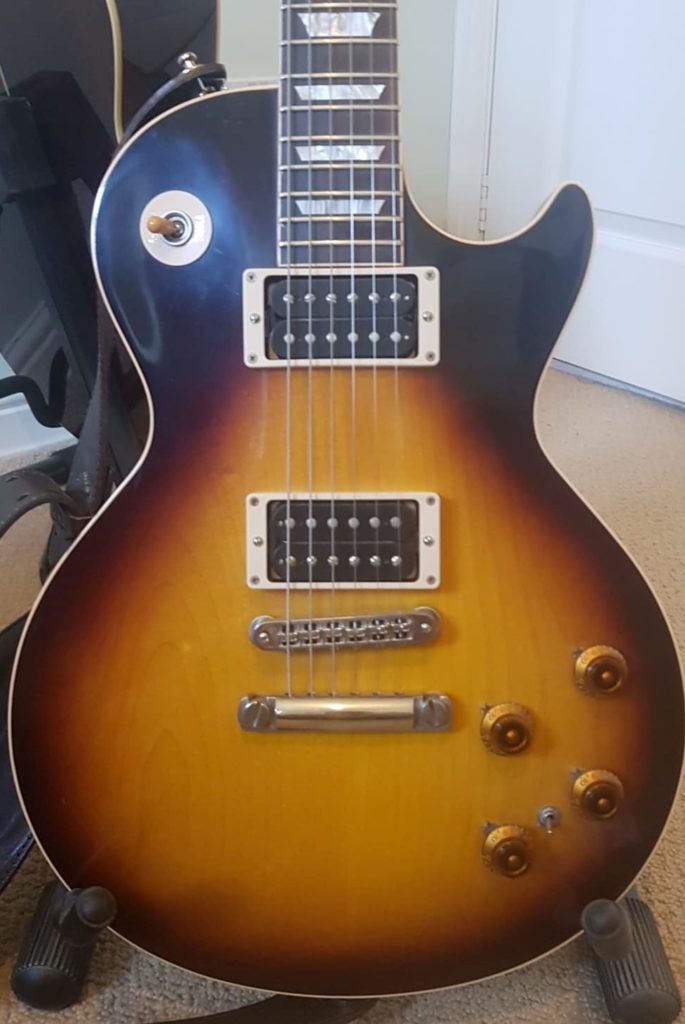
Neck
The PRS Custom 24 and the Gibson Les Paul both have pretty different neck types. The PRS has a wide thin profile. This means that it’s wide in terms of the fretboard, so if you looked at it laid out it’s back. The thin aspect, refers to the width of the neck if you looked over it whilst playing. It’s generally known as a pretty fast neck so it’s good for shredding, but not as good as something like an Ibanez neck.
The Gibson Les Paul has a rounded C-shape neck generally, however the neck shape does vary between models. It’s known for being thicker and fuller than the PRS neck, so it’s generally not as easy to shred. Some players prefer the feel of a thicker and wider neck though, it’s all personal preference so try both out.
The PRS has a slightly longer scale length (25″) compared to the Gibson Les Paul (24.75″). Both are shorter than something like a Fender Strat, so produce a resonant tone, however the shorter neck of the Gibson is generally regarded as better are producing this depth and warmth of sound. You will only get 22 frets on the Gibson though, compared to 24 frets on the PRS.
Both guitars usually use a rosewood fretboard and a set-neck in most cases.
Pickups
Both guitars have a dual humbucker configuration. This is great if you want a warm, deep tone that’s able to handle it when you crank up the gain.
However, the PRS Custom 24 also has a coil splitting function. This means that the humbuckers can be split to sound like single coil pickups by simply lifting the tone knob up. The tone isn’t usually as high quality as a traditional single coil pickup, but it is perfect if you want to add more versatility to your tone. Check out our post on coil splitting to learn more.
The Gibson Les Paul, however, has two tone and volume controls, compared to the PRS Custom 24 which only has one of each. With the Les Paul, you can control the tone and volume of each pickup independently, and then switch between each pickup to get a completely different rhythm and lead tone. But with the PRS, you can only adjust the overall volume and tone of the pickups, so you don’t get as much versatility in that respect.
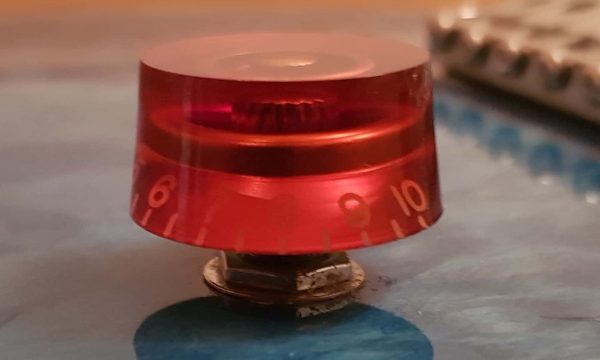
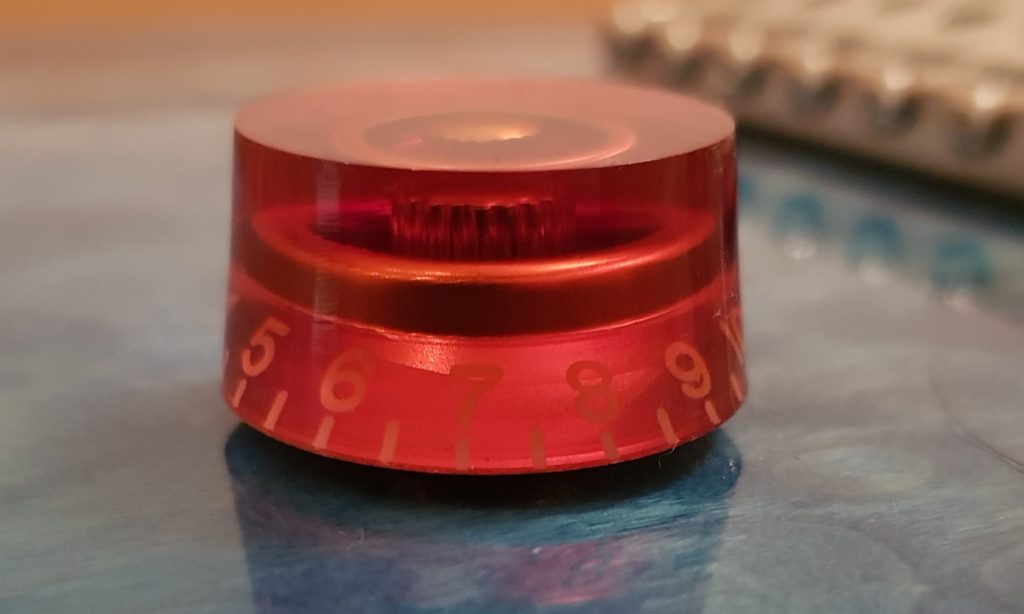
Coil Split (on the left) vs. Standard Humbucker (on the right)
Bridge
Another key difference between the two guitars, is in the bridge type. The PRS Custom 24 has a floating bridge, but the Gibson Les Paul has a fixed bridge.
Floating bridges are also known as tremolo bridges. They have the addition of a tremolo arm which when pushed or pulled on, changes the pitch of the strings, to give a vibrato effect. It’s a unique kind of sound that can only be achieved with a tremolo or with an effect pedal. The main disadvantages are that they’re hard to adjust, fragile and makes it a lot more difficult to change the strings.
Fixed bridges don’t have this tremolo arm, so their function is just to act as an end point for the strings on the guitar. The main advantages are that they are easy to maintain, setup and change the strings. Check out our post on fixed vs. floating bridges for some more information.
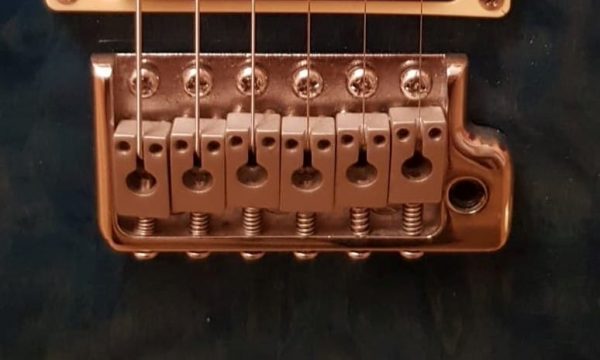
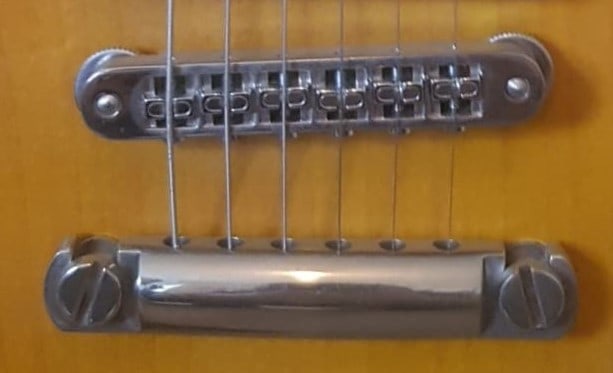
Price and Options
Next, we’ll move onto the price and different options in each range, starting with the PRS.
PRS Custom 24
The PRS Custom 24 line is split into two main versions, the SE (student edition) series and the USA Core series.
The USA core series is the more premium of the two. The guitars, are of course, made in the USA, and have higher quality electronics, are more thoroughly checked, produced by the top luthiers and usually have a better looking maple cap. However, they’re usually priced between $3500 to $4500.
The SE line is priced at around $900 and is super high quality for the price making it, in my opinion, one of the best value guitars out there. It’s produced in Korea, and you still get great features like the maple cap and bird inlays, but at a fraction of the price of a USA core guitar.
Gibson Les Paul
The Gibson Les Paul has a more complex line up. You can choose from the following models:
- Gibson Les Paul Standard
- Gibson Les Paul Modern
- Gibson Les Paul Classic
- Gibson Les Paul Studio
- Gibson Les Paul Tribute
The Standard is the flagship model, whilst the tribute is a more affordable option. Click the links to take a look at the best prices on Guitar Center.
If you want something more affordable though, then check out the Epiphone range. They’re owned by Gibson so still have the true Les Paul essence, but at a lower price point. Here are the main models, again you can click the link to check out the price on Guitar Center.
- Epiphone Les Paul Standard
- Epiphone Les Paul Custom
- Epiphone Les Paul Special
- Epiphone Les Paul Studio
Guitar Center are always the first place I look at when I’m interested in a new electric guitar because have a huge range of models for sale and always have some excellent deals on. Here’s a link to take you directly to Guitar Center’s electric guitar range so you can see all the offers available at the moment.
I’ve written a complete buyer’s guide for electric guitars which takes you through all the things you need to consider and a step-by-step method to narrowing down your selection and choosing the best option. Here is a link to the article.
Which is Best?
I know you’re probably not hear for a wishy washy answer, but unfortunately there isn’t a definitive answer to which is best. It more depends what you’re after.
If you’re looking for a true iconic classic guitar then you’ll probably lean towards the Gibson Les Paul. But if you want something a bit different looking, lighter, and with a coil splitting function, then you’ll love the PRS Custom 24.
It’s all about figuring out what’s important to you, and what features you need. It’s best to actually try both guitars in the store back to back, and you’ll naturally lean towards one. Check out our post on how to properly test a guitar to make the most of your trip.
If you’re looking for a great price, then check out Guitar Center. When purchasing my PRS, I tried it in store but then ordered it online because the price and colour options were better. Don’t be afraid to purchase a guitar online, as long as you pick a well-renowned shop like Guitar Center, then you’ll be completely fine.
In Conclusion
Here’s a quick round up of all the features we’ve discussed to help you decide which guitar is best for you.
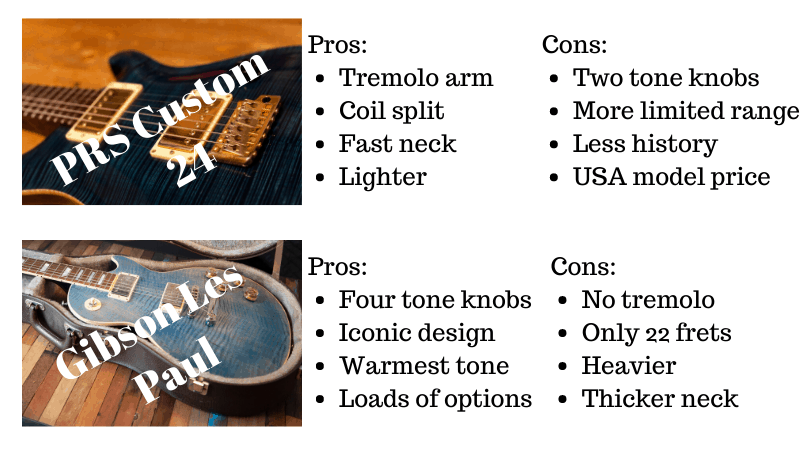
Pick the PRS Custom 24 If you want
- A more unique look
- Coil split humbuckers
- Double cutaway body
- A fast neck
- A tremolo arm
Pick the Gibson Les Paul if you want
- The classic look
- More tone controls
- Single cutaway body
- A thick neck
- A fixed bridge
So there you go! There’s the in-depth comparison between the PRS Custom 24 and Gibson Les Paul! I hope you’ve found this article helpful, thanks for reading. Here are some other posts you might find useful:
